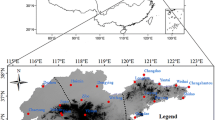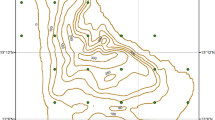Abstract
Impacts of the changing climatic regime on the trends of Indian summer monsoon rainfall (ISMR) are explored in this study for the Indian Himalayan region (IHR). The analysis is carried out for the period of 1951–2007 using a daily high resolution gridded data from APHRODITE project. At first, the percent departures of decadal rainfall are estimated from the long-term June to September rainfall values for the western, central, and eastern Himalayan (WH, CH, and EH) regions. Next, changes in the frequency of strong and weak phases of monsoon intra-seasonal oscillation are investigated. A non-parametric statistical method (Sen’s slope estimator) is applied to the seasonal (i) mean rainfall, (ii) maximum rainfall, and (iii) frequency of extreme rainfall events of WH, CH, and EH regions to identify changes in their decadal, multiple year normals (NY1; 1951–1980 and NY2; 1981–2007) and long-term (NY3; 1951–2007) trends. The inter annual to inter decadal variabilities of the frequency of extreme rainfall events are explored by analyzing statistically significant intrinsic mode functions of the empirical mode decomposition (EMD) method. Results of our analyses have revealed existence of an alternative decadal oscillation of scanty and excessive summer monsoon rainfall trends for the WH, whereas excessive rainfall is observed in the last three decades (1980–2007) over the CH region. It is also observed that the frequencies of both monsoon strong and weak phases are decreasing for the entire Himalayan region. No significant trend is observed for the WH and CH regions for the normal periods NY1, NY2, and NY3 when seasonal average rainfall is considered. However, a significant (p value < 0.05) negative trend of −0.04 mm/day rain is observed for the EH region during NY1 period. Similarly, the seasonal maximum rainfall trends for all the normal periods are found to be negative of which trends of −0.12 and −0.43 mm/day during NY3 and NY1 are observed for WH and EH regions, respectively (p value < 0.05). No significant enhancement in the extreme rainfall event frequencies is observed for the entire IHR during 1951–2007. However, a statistically insignificant positive trend in the extreme event frequencies is observed for the EH region. A dominant cycle of ∼ 2.7 years of high frequency of extreme rainfall events is observed for all the regions whereas, a 12.2-, 15.3-, and 5.8-year cycles are observed for the WH, CH, and EH regions, respectively.








Similar content being viewed by others
References
Andermann C, Bonnet S, Gloaguen R (2011) Evaluation of precipitation data sets along the himalayan front. Geochem Geophys Geosyst 12:Q07,023–Q07,039
Archer D, Fowler H (2004) Spatial and temporal variations in precipitation in the Upper Indus Basin, global teleconnections and hydrological implications. Hydrol Earth Syst Sci 8:47–61
Barros A, Kim G, Williams E, Nesbitt S (2004) Probing orographic controls in the Himalayas during the monsoon using satellite imagery. Nat Hazards Earth Syst Sci 4:29–51
Barry R (2008) Mountain weather and climate. Cambridge University Press, Cambridge
Bhutiyani M, Kale V, Powar N (2010) Climate change and the precipitation variations in the Northwestern Himalaya: 1866006. Int J Climatol 30:535–548
Borgaonkar H, Pant G, Kumar K (1998) A study of seasonal pattern and magnitudes of climatological inputs to the hydrology of Western Himalaya. In: Tappeiner U, Ruffini FV, Fumai M (eds) Head-Water’98 hydrology, water resources and ecology of mountain areas
Dimri A, Yasunari T, Wiltshire A, Kumar P, Mathison C, Ridley J, Jacob D (2013) Application of regional climate models to the Indian winter monsoon over the western Himalayas. Sci Total Environ 468–469S:S36—S47
Duffy D (2004) The application of Hilbert-Huang transforms to meteorological datasets. J Atmos Ocean Technol 21:599–611
Dwivedi S, Mittal A (2007) Forecasting the duration of active and break spells in intrinsic mode functions of indian monsoon intraseasonal oscillations. Geophys Res Lett 34(L16827):1–5. doi:10.1029/2007GL030540
Fowler HJ, Archer DR (2006) Conflicting signals of climatic change in the upper indus basin. J Clim 19(17):4276–4293
Gadgil S, Rao P (2000) Famine strategies for a variable climate—a challenge. Curr Sci 78:1203–1215
Goswami B, Venugopal V, Sengupta D, Madhusoodanan M, Xavier P (2006) Increasing trend of extreme rain events over India in a warming environment. Science 314:1442–1445
Guhathakurta P, Rajeevan M (2008) Trends in the rainfall pattern over India. Int J Clim 28:1453–1469
Holder H, Bolch A, Avissar R (2011) Processing turbulence data collected on board the helicopter observation platform (HOP) with the empirical mode decomposition (EMD) method. J Atmos Ocean Technol 28:671–683. doi:10.1175/2011JTECHA1410.1
Huang N, Shen Z, Long S, Wu M, Shih H, Zheng Q, Yen N, Tung C, Liu H (1998) The empirical mode decomposition and the hilbert spectrum for nonlinear and non-stationary time series analysis. Proc R Soc Lond Ser A 454:903–995
IPCC (2007) Ipcc fourth assessment report. Tech. rep., Inter governmental pannel on climate change
Jones P, Moberg A (2003) Hemispheric and large-scale surface air temperature variations: an extensive revision and an update to 2001. J Clim 16:206–223
Joshi S, Kumar K, Joshi V, Pande B (2013) Rainfall variability and indices of extreme rainfall-analysis and perception study fortwo stations over central himalaya. Nat Hazards doi:10.1007/s11069-013-1012-4
Khan A (2001) Analysis of hydro-meteorological time series: searching evidence for climate change in the Upper Indus basin. Tech. rep., International Water Management Institute (IWMI), Pakistan, Lahore Working Paper 23
Kulkarni A, Patwardhan S, Krishna Kumar S, Karamuri A, Krishnan R (2013) Projected climate change in the Hindu Kush-Himalayan region by using the high-resolution regional climate model PRECIS. Mt Res Dev 33:142–151
Kumar V, Jain S (2010) Trends in seasonal and annual rainfall and rainy days in Kashmir Valley in the last century. Quat Int 212:64–69
Kumar V, Singh P, Jain S (2005) Rainfall trends over Himachal Pradesh, Western Himalaya, India In: Proceeding conference development of hydro power projects—a prospective challenge. Shimla
Lundquist J (2003) Intermittent and elliptical inertial oscillations in the atmospheric boundary layer. J Atmos Sci 60:2661–2673
Mathison C, Wiltshire A, Dimri A, Falloon P, Jacob D, Kumar P, Moors E, Ridley J, Siderius C, Stoffel M, Yasunari T (2013) Regional projections of North Indian climate for adaptation studies. Sci Total Environ 468–469S:S4—S17
Mukherjee S, Shukla R, Mittal A, Pandey A (2011) Mathematical analysis of a chaotic model in relevance to monsoon ISO. Meteorol Atmos Phys 114:83–93. doi:10.1007/s00703-011-0159-3
Pan J, Yan X, Zheng Q, Liu W, Klemas V (2002) Interpretation of scatterometer ocean surface wind vector EOFs over the northwestern Pacific. Remote Sens Environ 84:53–68
Pant G, Borgaonkar H (1984) Climate of the hill regions of Uttar Pradesh. Himal Res Dev 3:13–20
Pant G, Rupa Kumar K, Borgaonkar H (1999) Climate and its long-term variability over the Western Himalaya during the past two Centuries. In: Dash SK, Bahadur J (eds) The himalayan environment. New Age International (P) Limited Publishers, New Delhi
Parthasarathy B, Munot A, Kothawale D (1994) All-India monthly and seasonal rainfall series: 1871-19930. Theor Appl Clim 49:217–224
Pattanaik D, Rajeevan M (2010) Variability of extreme rainfall events over India during southwest monsoon season. Meteorol Appl 17:88–104
Rajeevan M, Bhate J, KD K, Lal B (2006) High resolution daily gridded rainfall data for the Indian region: Analysis of break and active monsoon spells. Current Sci 91:296–306
Rajeevan M, Bhate J, Jaswal A (2008) Analysis of variability and trends of extreme rainfall events over India using 104 years of gridded daily rainfall data. Geophy Res Lett L18707:1–6
Rajeevan M, Gadgil S, Bhate J (2010) Active and break spells of the Indian summer monsoon. J Earth Syst Sci 119(3):229–247
Sen P (1968) Estimates of the regression coefficient based on Kendall’s tau. J Am Stat Assoc 39:1379–1389
Sharma K, Moore B, Vorosmarty C (2000) Anthropogenic, climatic and hydrologic trends in the Kosi Basin, Himalaya. Clim Chang 47:141–165
Shrestha A, Wake C, Dibb J, Mayweski P (2000) Precipitation fluctuations in the Nepal Himalaya and its vicinity and relationship with some large scale climatological parameters. Int J Climatol 20:317–327
Shukla R (2013) The dominant intraseasonal mode of intraseasonal South Asian summer monsoon. J Geophys Res 119:635–651
Singh P, Kumar N (1997) Impact assessment of climate change on the hydrological response of a snow and glacier melt runoff dominated Himalayan river. J Hydrol 193:316–350
Singh P, Kumar V, Thomas T, Arora M (2008) Changes in rainfall and relative humidity in different river basins in the northwest and central India. Hydrol Process 22:2982–2992
Singh R, Sen-Roy S (2002) Climate variability and hydrological extremes in a Himalayan catchment. In: ERB and Northern European FRIEND Project 5 Conference. Slovakia
Subash N, Sikka A, Ram Mohan H (2011) An investigation into observational characteristics of rainfall and temperature in central India - a historical perspective 1889-2008. Theor Appl Climatol 103:305–319
Wu Z, Huang N (2003) A study of the characteristics of white noise using the empirical mode decomposition method. Proc R Soc Lond Ser A 460:1597–1611
Yatagai A, Arakawa O, Kamiguchi K, Kawamoto H, Nodzu M, Hamada A (2009) A 44-year daily gridded precipitation dataset for asia based on a dense network of rain gauges. Sci Online Lett Atmos 5:137–140
Yatagai A, Kamiguchi K, Arakawa O, Hamada A, Yasutomi N, Kitoh A (2012) APHRODITE: Constructing a long-term daily gridded precipitation dataset for Asia based on a dense network of rain gauges. Bull Amer Meteorol Soc 93:1401–1415
Acknowledgment
Authors are thankful to the APHRODITE’s Water Resources project, supported by Environment Research and Technology Development Fund of the Ministry of the Environment, Japan, for the rainfall data. This work is a part of an In-House project of Watershed Process Management Group of GBPIHED, Kosi-Katarmal, Almora, India.
Author information
Authors and Affiliations
Corresponding author
Rights and permissions
About this article
Cite this article
Mukherjee, S., Joshi, R., Prasad, R.C. et al. Summer monsoon rainfall trends in the Indian Himalayan region. Theor Appl Climatol 121, 789–802 (2015). https://doi.org/10.1007/s00704-014-1273-1
Received:
Accepted:
Published:
Issue Date:
DOI: https://doi.org/10.1007/s00704-014-1273-1




